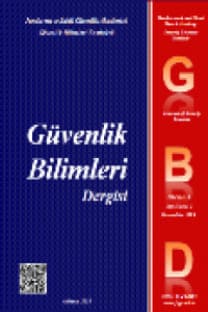TERÖRİSTLE MÜCADELEDE KULLANILAN SİLAH SİSTEMLERİNİN ETKİNLİKLERİNE YÖNELİK ALGILARIN BELİRLENMESİ
Güvenlik güçlerinin düşük yoğunluklu çatışma ortamında otuz yıldır bölücü terör örgütü Kürdistan İşçi Partisi (PKK) ile yürüttüğü başarılı mücadele bilinen bir gerçektir. Mücadele sürecinde güvenlik güçleri tarafından düşük yoğunluklu çatışma ortamında farklı teknik özelliklere ve teknolojilere sahip silah sistemleri kullanılmıştır. Özellikle son yıllarda teknolojide meydana gelen hızlı değişim, silahlı kuvvetlerin tedarik süreçlerinin sürelerine bağlı olarak düşük yoğunluklu harekât ortamında da görülmüştür. Her zaman en önemli kuvvet çarpanı olarak algılanan teknoloji, teröristle mücadelenin önemi doğrultusunda düşük yoğunluklu çatışma ortamını sürekli etkilemiştir. Harekât alanında kullanılan tüm silah sistem teknolojilerinin zamanla nasıl bir değişim gösterdiğinin değerlendirilmesi ve teknolojinin düşük yoğunluklu çatışma ortamını ne derecede etkilediğinin ortaya konulması önem taşımaktadır. Çalışmanın amacı, teknolojik gelişimin silah sistemleri üzerinde yarattığı etkinliğin, bizzat bu süreçte görev yapmış personelin algılarına dayanarak belirlenmesidir. Bu çalışma ile güvenlik güçlerinin kullandığı harp silah, araç ve gereçlerinin etkinlik dereceleri teröristle mücadelede görev yapmış uzman personelin algılarına dayalı olarak, literatürde yaygın olarak kullanılan, Analitik Hiyerarşi Süreci (Analytic Hierarchy Process-AHP) ve İdeal Çözüme Yakınlıkla Tercih Sıralama Yöntemi (Technique for Order Preference by Similarity to Ideal Solution-TOPSIS) metodolojileri izlenerek belirlenmiştir. Çalışma sonucunda teröristle mücadelede kullanılan harp silah, araç ve gereçlerinin algılanan etkinlik derecelerine göre sıralaması elde edilmiştir. Elde edilen sıralama incelendiğinde, silahlı ve genel maksat helikopterlerinin teröristle mücadelede diğer sistemlere göre daha etkin olarak algılandıkları sonucuna ulaşılmıştır.
Anahtar Kelimeler:
Silah Sistem Etkinliği, Çok Kriterli Karar Verme, AHP, TOPSIS, PKK
DETERMINING PERCEPTIONS TOWARDS THE EFFECTIVENESS OF WEAPON SYSTEMS USED IN COUNTER-TERRORIST OPERATIONS
It is a very well known fact that for thirty years Turkish security forces have successfully been struggling with the separatist terrorist organization, Kurdistan Workers' Party (PKK). During this struggle in the low intensity conflict environment, security forces have used weapon systems with different technical features and technologies. Particularly in recent years, the rapid improvement in technology has also been occurred in the low intensity conflict operations depending on the procurement processes of the security forces. Technology, considered as an important force multiplier, has always affected the low intensity conflict operations due to the importance of the counter-terrorist operations. It is vital to inspect the evolution of all the weapon systems used in the combat zone and have deeper knowledge about how they affect the low intensity conflicts. From this perspective, this study aims to determine the perceptions of the specialists towards the effectiveness of weapon systems used in counter-terrorist operations. The effectiveness of the weapon systems are determined depending on the perceptions of the experienced personnel in counter-terrorist operations and using Analytic Hierarchy Process (AHP) and Technique for Order Preference by Similarity to Ideal Solution (TOPSIS) methodologies, which are widely used in the literature. Following these methodologies, a ranking of the weapon systems that are used in counter terrorist operations was achieved in terms of the perceived effectiveness of those weapon systems. The ranking order shows that attack and utility helicopters are perceived more effective in countering terrorists than the other weapon systems.
Keywords:
Weapon System Effectiveness, Multi Criteria Decision Making, AHP, TOPSIS, PKK,
___
- Bal, İ. (2006). Alacakaranlıkta Terörle Mücadele ve Komplo Teorileri. Ankara: USAK Yayınları.
- Blanchard, B.S. ve Fabrycky,W.J. (2011). System Engineering and Configuration Management. New Jersey: Prentice Hall.
- Headquarters of Department of Army (1993). FM 100-5 Operations. Washington, D.C.
- Hwang, C.L. ve Yoon K. (1981). Multiple Attribute Decision Making: Methods and Applications. New York: Springer-Verlag,
- Özdağ, Ü. (2007). Türk Ordusunun PKK Operasyonları. İstanbul: Pegasus Yayınları.
- Özeren, S. ve Sever, M. (2011). Terörizm Paradoksu ve Türkiye. İçinde M.Sever (Ed.), Giriş (ss. 11-21). Ankara: Karınca Yayınları.
- Paul, C., Clarke, C.P. ve Grill, B. (2010). Victory Has a Thousand Fathers. Santa Monica: RAND Corporation.
- Saaty, T.L. (1980). The Analytic Hierarchy Process: Planning, Priority Setting, Resource Allocation. New York: McGraw-Hill.
- Saaty, T.L. (2000). Fundamentals of Decision Making and Priority Theory. Pittsburgh: RWS Publications.
- Yoon, K.P. and Hwang C. (1995). Multiple Attribute Decision Making: An Introduction. Thousand Oaks: SAGE Publications.
- ISSN: 2147-2912
- Yayın Aralığı: Yılda 2 Sayı
- Başlangıç: 2012
- Yayıncı: JANDARMA VE SAHİL GÜVENLİK AKADEMİSİ
Sayıdaki Diğer Makaleler
ULUSLARARASI POLİTİKA VE BİRLEŞMİŞ MİLLETLER SİSTEMİNDE ÖNALICI KUVVET KULLANMA
TERÖRİSTLE MÜCADELEDE KULLANILAN SİLAH SİSTEMLERİNİN ETKİNLİKLERİNE YÖNELİK ALGILARIN BELİRLENMESİ
UNDERSTANDING AND DEFINING ETHNIC IDENTITY: AHISKA/MESKHETIAN TURKS IN A MIDWESTERN AMERICAN CITY
1915 TEHCİRİNDEN 1992 HOCALI’YA SOYKIRIM İDDİALARI ÇERÇEVESİNDE ERMENİ SORUNU
STRATEJĠK SAVUNMA VE GÜVENLĠK PLANLAMASINDA ORTAK BĠR YAKLAġIM OLARAK SENARYO TEMELLĠ PLANLAMA
